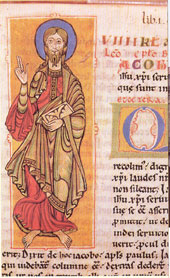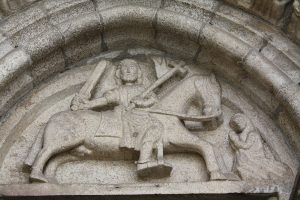On Tuesday we explored medieval motives for walking the Camino de Santiago, or the Way of St. James. It struck me that, although we hear a lot about the Camino—the walk itself and the pilgrims who undertake it—we don’t hear nearly as much about St. James, or at least the St. James enshrined in the cathedral and imagined by medieval pilgrims.
Do pilgrims today even walk the Camino in order to visit the shrine of St. James? It seems that the journey has become more important than the destination.
In keeping with my idea that (in the Middle Ages, at least) the destination is key, I thought we’d take a look at some facts and legends surrounding St. James, the man behind the Camino.

Facts: You probably already know that James the Greater was one of the twelve disciples. He was the brother of John, the beloved disciple. James was one of three to witness the Transfiguration (Mark 9:2-13; Matthew 17:1-13; Luke 9:28-36) and Jesus’ agony in the garden (Matthew 26:37-46; Mark 14:33-42). He is the only disciple whose martyrdom is recorded in the New Testament (Acts 12:1-2).
It’s certainly understandable that the Camino became so popular. James was part of Jesus’ inner circle. His relics brought a bit of the Holy Land to Europe. Pilgrims (whatever their motives) could touch and pray to a saint who had been close to the savior.
Uncertainty: We move into uncertainty, if not legend, when we consider the belief, popular in the Middle Ages, that James brought the Gospel to Spain. According to medieval sources, he preached in Iberia before returning to Judea, where he was beheaded.
Legends: There are several stories about what happened next. According to the Golden Legend of Jacobus de Voragine (ca. 1260), James’s disciples loaded his remains onto a boat and, without sail or rudder, were conducted by an angel to Galicia.
And then the disciples of S. James took out his body and laid it upon a great stone. And anon the stone received the body into it as it had been soft wax, and made to the body a stone as it were a sepulchre.
More miracles ensued as James’s disciples dodged an angry Spanish queen. My favorite is when they split a fire-breathing dragon in two by making the sign of the cross. You have to love how dragons are incorporated as often as possible in medieval stories and hagiography!
